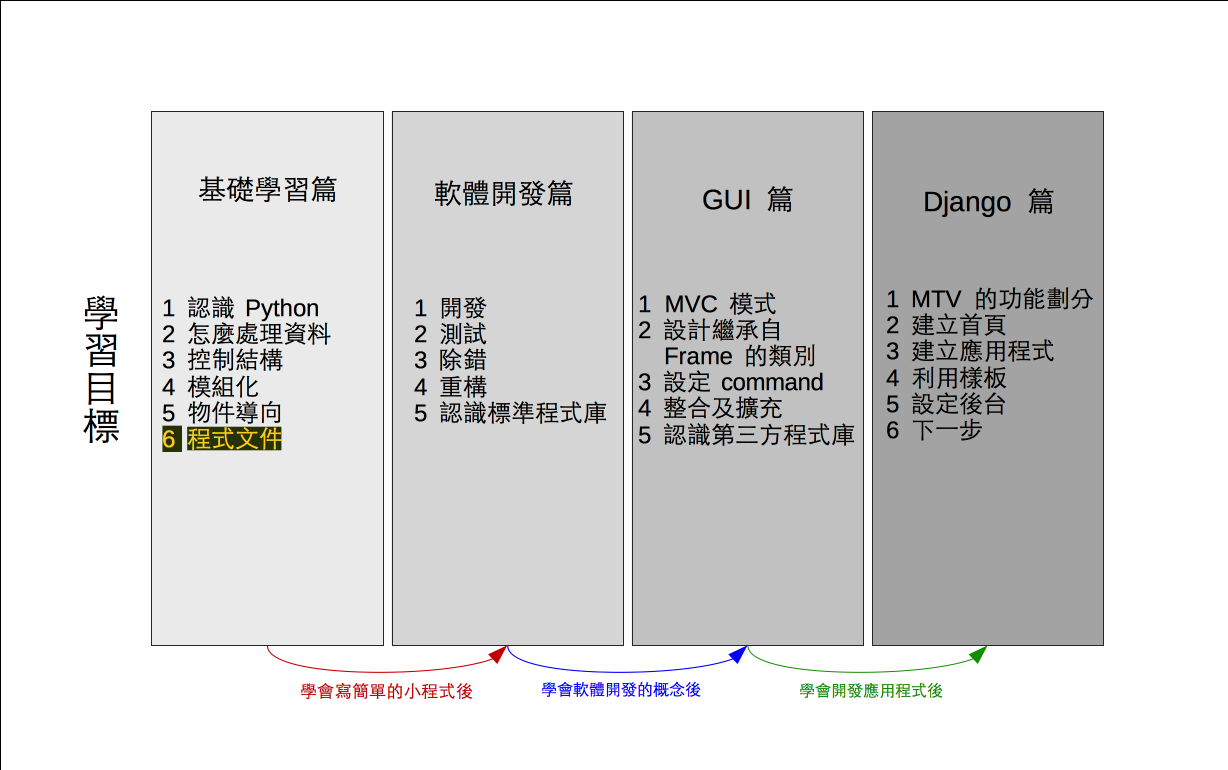

文件字串 (documentation string) 定義在模組 (module) 、函數 (function) 、類別 (class) 及方法 (method) 中,用為程式的說明文件,可用預設屬性 (attribute) __doc__ 存取
說明文件不外是解釋程式某部分的使用方式,通常會舉出簡單的例子,傳統程式語言 (programming language) 的說明文件大都是額外編寫,印成紙書或放在網路供人查詢,或是以註解 (comment) 形式加進原始程式碼 (source code) 中, Python 文件字串的特點讓程式設計師可以邊寫程式邊查文件,無須翻紙書或查網路。
我們先進入 Python 的互動式介面來看看吧!下面印出內建函數 int() 的屬性 __doc__
| $ python |
| Python 3.6.5 (v3.6.5:f59c0932b4, Mar 28 2018, 05:52:31) |
| [GCC 4.2.1 Compatible Apple LLVM 6.0 (clang-600.0.57)] on darwin |
| Type "help", "copyright", "credits" or "license" for more information. |
| >>> print(int().__doc__) |
| int(x=0) -> integer |
| int(x, base=10) -> integer |
| Convert a number or string to an integer, or return 0 if no arguments are given. If x is a number, return x.__int__(). For floating point numbers, this truncates towards zero. |
| If x is not a number or if base is given, then x must be a string, bytes, or bytearray instance representing an integer literal in the given base. The literal can be preceded by '+' or '-' and be surrounded by whitespace. The base defaults to 10. Valid bases are 0 and 2-36. Base 0 means to interpret the base from the string as an integer literal. |
| >>> int('0b100', base=0) |
| 4 |
| >>> |
int() 用來建立整數物件 (object) ,因此回傳一個整數物件,這裡可以看到 int() 的解釋與用法。
| >>> print([].__doc__) |
| list() -> new empty list |
| list(iterable) -> new list initialized from iterable's items |
| >>> |
串列的文件字串只有簡單印出用法,大體上文件字串是依需要來設置。文件字串分成兩種,一種是單行的文件字串,另一種則是多行,下面我們用單元 8 的 big() 函數示範單行文件字串的寫法
def big(a, b):
"""回傳較大的參數。"""
if a > b:
return a
else:
return b文件字串採用三個引號,也就是字串前後都用三個引號圍起來,單行的文件字串就是簡單的寫明函數用途
"""回傳較大的參數。"""多行的文件字串同樣用三引號字串 (triple-quoted string) ,如下例
def big(a, b):
"""回傳較大的參數。
參數:
a - 第一個參數。
b - 第二個參數。
"""
if a > b:
return a
else:
return b第一行同樣是函數用途,之後空一行,下面才是進一步的解釋說明,此例解釋參數 (parameter) 的用途。有沒有發現三引號字串是可以跨行的呢?是的,三引號字串可以跨行,因為三引號字串的主要用途就是當作文件字串,文件字串通常是多行的敘述。
下面我們替 class_dmeo9.py 加進模組、類別與方法的文件字串
"""Demo 類別的範例。
這個模組示範文件字串的寫法。"""
#類別的註解。
class Demo:
"""類別的文件字串。"""
# __init__() 的註解。
def __init__(self, v1=11, v2=22):
""" __init__() 的文件字串。"""
self.__a = v1
self.__b = v2
# 方法的註解。
def do_something(self):
"""方法的文件字串。"""
return self.__a + self.__b
if __name__ == "__main__":
d = Demo(12, 34)
print(d.do_something())
#《程式語言教學誌》的範例程式
# http://kaiching.org/
# 檔名:class_demo10.py
# 功能:示範 Python 中的文件字串
# 作者:張凱慶 */這裡僅作示範用,因此文件字串中都採取簡單的文字。
我們可以看到模組的文件字串出現在檔案的最開始,類別、方法或函數的文件字串都在關鍵字 (keyword) 的下一行,至於註解則在關鍵字的上一行,除了文件字串的位置須固定外,註解的位置是 Python 社群的習慣寫法,如果要對整個類別、方法或函數做註解,通常都會寫在關鍵字的上一行。
由於文件字串是用途及簡單例子,所以註解內容不應該與文件字串相同或相似,基本上註解的目的主要是對程式碼額外說明,至於說明內容依需要而定。
倒是不管文件字串或是註解都應按照開發團隊的習慣來走,我們這裡介紹的是官網 PEP 8 及 PEP 257 所建議的寫法。
接下來我們開發軟體的方式,帶領讀者開發 GUI 的編密碼軟體,藉此介紹更多的 Python 特性囉!
| 中英文術語對照 | |
|---|---|
| 屬性 | attribute |
| 類別 | class |
| 註解 | comment |
| 文件字串 | documentation string |
| 函數 | function |
| 關鍵字 | keyword |
| 串列 | list |
| 方法 | method |
| 模組 | module |
| 物件 | object |
| 參數 | parameter |
| 程式語言 | programming language |
| 原始程式碼 | source code |
| 三引號字串 | triple-quoted string |
| 重點整理 |
|---|
| 1. 文件字串用以說明模組、函數、類別及方法的功能,可用預設屬性 __doc__ 存取。 |
| 2. 定義文件字串採用可以跨行的三引號字串,放在模組的開頭或 class 、 def 的下方第一行。 |
| 問題與討論 |
|---|
| 1. 文件字串是什麼?為什麼要在程式中設置文件字串? |
| 2. 什麼是三引號字串?這跟字串有什麼不同? |
| 練習 |
|---|
| 1. 寫一個程式 exercise1301.py ,替 exercise1201.py 加入文件字串。 |
| 2. 寫一個程式 exercise1302.py ,替 exercise1202.py 加入文件字串。 |
| 3. 寫一個程式 exercise1303.py ,替 exercise1203.py 加入文件字串。 |
相關教學影片
